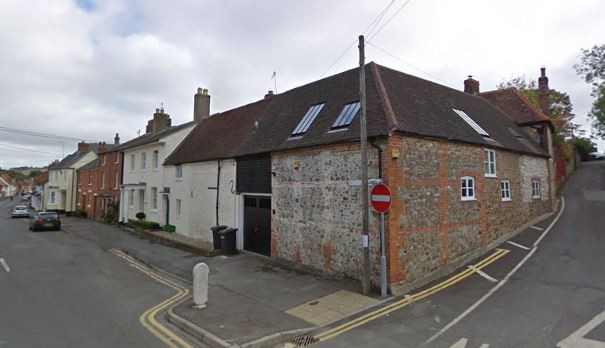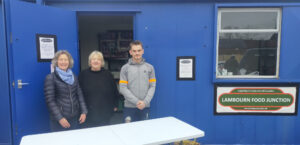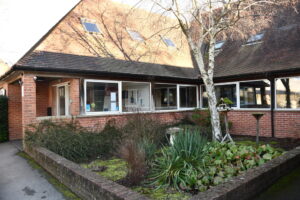
John Carter, set fire to the stables belonging to The Red Lion after a row with his employer over extra wages. For this and other acts of arson, he was found guilty and hanged in Reading prison. He was the last person hanged for arson in Berkshire and was buried in Lambourn churchyard where his stone tells the story as a warning to all.

The tomb-stone can be seen close to the railings on the North side of the churchyard which reads:

Here
Lies the body
of JOHN CARTER
of this parish, labourer,
who in defiance of the laws
of God and man
wilfully and maliciously
set fire in two places to this town of Lambourn
on the 19th day of November 1832
and was executed at Reading
in the 30th year of his age
on the 16th day of March 1833
having desired that his body
might be interred here as a warning to his companions
and others who may hereafter
read this memorial to his
untimely end.
The wages of sin is death
Repent and turn yourselves from
All your transgressions and so iniquity
Shall not be your ruin
His crime was to set fire to a pub and other buildings in the centre of Lambourn. This resulted in the devastation of several buildings and in the death of horses in the adjoining stables. He had been married for only a year and was father to two young children. He had involved three other local men who were acquitted.
Report from Devizes and Wiltshire Gazette.
Villager, John Carter, Lambourn Incendiaries.
March 1833
It will be recollected that John Carter, convicted of arson, at Lambourn, was executed on Saturday the 16th inst. In the evening of Friday, the day previous to his execution, three effigies intending to represent Robert Chivers, who had been Carter’s accomplice, but was admitted an approver for the Crown, and Wm.Winkworth, and Henry Rider, who had been charged as accessories’ before the fact, but acquitted, were placed in a cart drawn by one horse, and paraded through the streets of Lambourn, having a person in the cart intended to represent “Jack Ketch;” after which a mock trial of the three individuals was held in the Market-place. They were found Guilty, – and from thence removed to an execution, near the town, and within the sight of the scene of their crimes, where they were hanged, and afterwards burnt. – Seldom if ever, was there such a number of agricultural labourers seen assembled together in Lambourn; the market place was literally crammed, and the whole proceedings were conducted with a solemnity which would not have disgraced a more awful tribunal : a proof that the agricultural labourers generally, like other honest men, abhor the crime for which Carter suffered Lambourn Arsonist, was the last man to be hanged at Reading gaol.
General information:
John Carter (son of John Carter and Elizabeth Harper) was born 1802 in Lambourn, Berkshire, and died 16th March 1833 in reading Gaol. He married Elizabeth Ball on 28th November 1831 in Lambourn Berkshire, daughter of Robert Ball and Hannah Locke. The children of John Carter and Elizabeth Ball were William Carter born 1830 and Hannah Carter born 1832
Liz Beard 2017
The Swing riots of the 1830’s
The Swing Riots were a widespread uprising in 1830, by mainly agricultural workers across southern England. It was due to bad working conditions, poor rates, and the introduction of mechanisation, which was a major factor. The first threshing machines were destroyed on August 28th 1830, and by the October more than a hundred had been destroyed across Kent, where the uprising started.
Three causes were the Tythe system, the Poor Law, and the tenant farmers, who kept lowering the wages. The previous two years had seen poor harvests due to bad weather.
The ‘Swing Riots’ name, originated from a fictitious Captain Swing, who signed threatening letters to farmers, magistrates, parsons and the like. The name ‘Swing’ referred to the ‘swinging stick’ or flail, that was used to thresh the grain in hand threshing. The was time consuming and the new threshing machines did the job in a fraction of the time, but, of course, with much limited labour.
In the 1780’s workers were employed at annual Hiring Fairs, or Mop Fairs and the workers were treated reasonably well by their employer, but as time went on, the gulf between employer and employee, widened considerably and the farm worker became impoverished.
The threatening letters called for a rise in wages, a cut in the tythe payments and for the destruction of the machines.
Eventually, the farmers agreed to raise wages and tythe rents were reduced in some cases, but many farmers reneged on the agreements and the unrest increased. Reform, then was the solution and this was suggested in Parliament by Earl Grey. However, the Prime Minister, the Duke of Wellington (he of Napoleon Bonaparte’s downfall) was adamant that the current reform was perfect and could not be improved upon. With this arrogant attitude, a mob attacked Wellington’s home in London. However, on the 15th November 1830, Wellington’s government was defeated in a vote and Earl Grey was asked to form the Whig Government. (The Whig Party were from the 1680’s to the 1850’s and became the Liberal Party in opposition to the Conservatives but by 1912 it had merged into the Conservative Party)
The disturbances continued though, and the landowners began to respond to the protesters with harsh, punitive measures. By 1831, nearly 2000 protesters were brought to trial. 252 were sentenced to death, although only 19 were hanged. 644 were imprisoned and 481 were transported to Australia. (Some records differ in the numbers)
Not all were farm workers though, as others were carpenters, shoemakers, wheelwrights, blacksmiths etc.
The workers wanted a minimum wage of 2/3d a day in winter (13/6d weekly) and 2/6d a day in summer (15/- weekly)
The average wage then was 8/4d a week.
In 1795, the average wage was 8/11d per week and by 1850, it had risen to 9/6d a week. Still not reaching the workers requests even by then.
Unrest prevailed, therefore, and John Carter was still incensed in 1832, he may, of course, had a personal grievance as well, against Mr Spicer of the malt-house and proprietor of the Red Lion, Lambourn, but records don’t say. He set fire to the malt-house building and to the Red Lion stables, tragically killing two horses there in the process.
In the records, the malt-house is described as being opposite the Crowle Road, so I don’t believe it to be on the corner belonging to Windsor House stables.

Probably more likely is the building opposite on the corner of Edwards Hill and the High Street (as above) as it is reported to have been a coach house and the large doors facing the High Street suggests just that. There were certainly stables there at one time, as Capt James Randall Bereford Cramsie (1892-1962) held a Flat licence there from 1925-1940, and NH horses, when he had 7 horses in 1934, and 3 in 1937. After the war, he assisted Tom Rimell, over the road at Windsor House Stables, He lived at Downs House and died there in February 1962, aged 69.
John Carter was hanged at the top of Reading gaol on March 16th 1833 and it is said that over 5000 people came to witness the hanging.
John Carter was the last man hanged in England for the crime of arson. There are, of course, many references to the Swing Riots and those desperate times, online. One of them is entitled ‘Berkshire to Botany Bay’. The 1830 Labourers revolt in Berkshire. It’s causes and consequences.
Mick Dowdeswell
January 2021





I believe John Cartercto be my great great uncle through my mother’s line.
Interesting stuff.
Now that is interesting! Pleased you liked the page David.
Hi
I am the Great Great Great Great Grandson of Robert Chivers.
I have been doing some ancestral research for the Chivers family.
I am wondering if there are any distant cousins or family members still in Lambourn or desendents connected to Robert Chivers and Mary Chivers (Povey).
Both Robert and Mary along with all their kids with the eldest being married to a Greg. They all ended up settling in Canada shortly after the trial in 1833.
It be nice to make some kind of contact and maybe complete a family tree.
Thanks in advance
Eric Chivers
Hello Eric, thank you for contacting the Lambourn Website. How interesting to know where Robert and family disappeared to. I will email you.
John Carter is my Gt Gt Uncle through my fathers line.
Heather!…that is so interesting, thank you for sharing that with our Lambourn Website. We appear to have a David on here who has John Carter as his Gt Gt Uncle through his mothers line.
My great great great grandfather was Robert Chivers who came over to Canada (Ontario). There was always a vague rumour that the reason the Chivers came to Canada was because of his involvement in an arson (interestingly, I think the rumour suggested he and his brother were somewhat involved). So interesting to read this! I think I need to come to Lambourn to make amends for my GGG Grandfather and buy everyone at the local pub a pint.
I’m not fully sure if he owned a farm in Canada but I believe he did. His ancestors certainly did.
Thank you for visiting our Website and how interesting to hear from you regarding your Grt x 3 Grandfather. Love the humour and look forward to meeting up in the local in the near future (might resist a ‘pint’ though!) I am pleased that you found it an interesting read always delighted to hear from relatives. Best Regards Liz
I’m afraid that George Pulham was the last man to be hanged for arson and this was on 8th April 1835. He burnt down farm buildings in Lidgate, Suffolk was sentenced at the Suffolk Lent Assizes in March by. James Scarlett, 1st Baron Abinger and hanged at Bury St Edmunds Gaol. Ref in National Archives Kew HO 17/32/125
Yes, I believe so Anthony, not that I have much knowledge of that story. John Carter was the last one in Berkshire apparently, he certainly caused havoc!